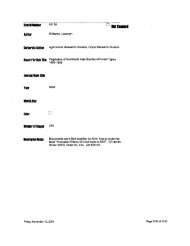Epidemiologic Investigation of Health Effects in Air Force Personnel ...
Epidemiologic Investigation of Health Effects in Air Force Personnel ...
Epidemiologic Investigation of Health Effects in Air Force Personnel ...
You also want an ePaper? Increase the reach of your titles
YUMPU automatically turns print PDFs into web optimized ePapers that Google loves.
phases <strong>of</strong> the study, produc<strong>in</strong>g a 1:1 morbidity design. The <strong>in</strong>itial questionnaire<br />
will look backwards <strong>in</strong> time and will reconstruct occupational, social,<br />
and medical data to quantitate morbidity endpo<strong>in</strong>ts and confound<strong>in</strong>g factors.<br />
Subsequent questionnaires and physical exam<strong>in</strong>ations will constitute a followup<br />
morbidity study <strong>of</strong> liv<strong>in</strong>g exposed subjects and suitable liv<strong>in</strong>g controls. In<br />
this followup phase, primary controls who are noncompliant will be replaced by<br />
another suitable control from the control set so that both statistical power<br />
and loss to study bias <strong>in</strong> the followup study may be improved. Controls dy<strong>in</strong>g<br />
after the <strong>in</strong>itiation <strong>of</strong> the followup will not be replaced. All RANCH HAND<br />
personnel and their primary controls will be asked to complete a questionnaire<br />
and participate <strong>in</strong> a comprehensive physical exam<strong>in</strong>ation, with special emphasis<br />
be<strong>in</strong>g placed on dermatologic, neuropsychiatric, hepatic, immunologic, reproductive,<br />
and neoplastic conditions.<br />
The questionnaire will be developed and adm<strong>in</strong>istered by a civilian op<strong>in</strong>ion<br />
research organization <strong>of</strong> national stature under contract to the U.S. <strong>Air</strong><br />
<strong>Force</strong>. In-home, face-to-face <strong>in</strong>terviews will b,e conducted to maximize data<br />
quality; however, noncompliant <strong>in</strong>dividuals will be requested to participate <strong>in</strong><br />
a shortened telephone <strong>in</strong>terview. Medical and occupational data will be<br />
obta<strong>in</strong>ed from the study subjects. Fertility data will be obta<strong>in</strong>ed from the<br />
subject's spouse and/or former spouses whenever possible, preferably by faceto-face<br />
<strong>in</strong>terview. In addition, next-<strong>of</strong>-k<strong>in</strong> <strong>in</strong>terviews will be obta<strong>in</strong>ed for<br />
all study subjects who have died <strong>of</strong> non-combat-related causes between the time<br />
<strong>of</strong> their assignment to SEA and the <strong>in</strong>itiation <strong>of</strong> this study. The physical<br />
exam<strong>in</strong>ations will be conducted under <strong>Air</strong> <strong>Force</strong> contract at a s<strong>in</strong>gle center by<br />
a civilian medical organization <strong>of</strong> national stature. Bl<strong>in</strong>d assessment protocols<br />
and strict quality control measures will be used to avoid bias and limit<br />
data variability. A $100 per day stipend will be paid to all eligible subjects<br />
to maximize participation <strong>in</strong> the study. Adaptive physical exam<strong>in</strong>ations<br />
and questionnaires will be developed for use <strong>in</strong> years 3, 5, 10, 15, and 20 <strong>of</strong><br />
the followup study. Expected biases and study difficulties <strong>in</strong>clude risktak<strong>in</strong>g<br />
behavior bias <strong>in</strong> the predom<strong>in</strong>antly volunteer RANCH HAND group, response<br />
bias, <strong>in</strong>terviewer bias, loss to study bias, and variability <strong>of</strong> procedures<br />
performed.<br />
S<strong>in</strong>ce this study is deal<strong>in</strong>g with nonspecific cl<strong>in</strong>ical endpo<strong>in</strong>ts, identification<br />
or elucidation <strong>of</strong> a disease state or syndrome by statistical methodology<br />
is a prime thrust <strong>of</strong> the <strong>in</strong>vestigation. Inferences about a disease<br />
state will be developed by identify<strong>in</strong>g symptom complexes or physical f<strong>in</strong>d<strong>in</strong>gs<br />
which <strong>in</strong> themselves may represent disease. By comparison <strong>of</strong> symptoms, signs,<br />
and laboratory tests with<strong>in</strong> and between groups, a logical decision-mak<strong>in</strong>g<br />
scheme can be utilized to calculate relative risks from basel<strong>in</strong>e data. If<br />
appropriate, these results will be used to sharpen adaptive approaches <strong>in</strong> the<br />
followup study. By the use <strong>of</strong> comb<strong>in</strong>ational and correlational analysis,<br />
statements about the probability <strong>of</strong> a disease state, a subcl<strong>in</strong>ical state,<br />
and/or over-report<strong>in</strong>g bias will be attempted. In addition, the application <strong>of</strong><br />
regression techniques to a normalized exposure <strong>in</strong>dex among exposed <strong>in</strong>dividuals<br />
exhibit<strong>in</strong>g symptoms and/or signs will also assist <strong>in</strong> the clarification <strong>of</strong> a<br />
disease state or syndrome. Mortality data will be analyzed us<strong>in</strong>g several different<br />
approaches, <strong>in</strong>clud<strong>in</strong>g age and age-disease specific rates, standardized<br />
mortality rates, and modified life table approaches, as well as more sophisticated<br />
logistic and multiplicative models. Analysis <strong>of</strong> questionnaire and<br />
vii
















